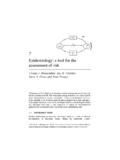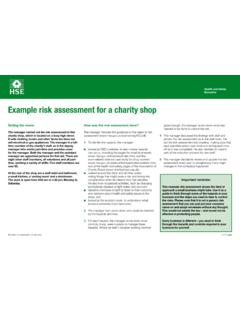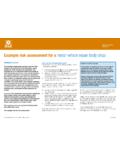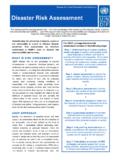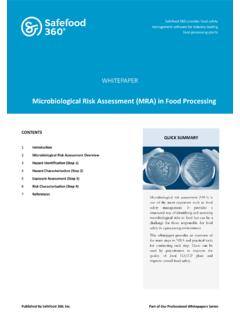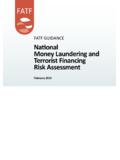Transcription of PSF Risk Benefit Assessment Form Worked Example (ENG)
1 1 Introduction The Play Safety Forum, formed in 1993, exists to consider and promote the wellbeing of children and young people through ensuring a balance between safety, risk and challenge in respect of play and leisure provision. Managing Risk in Play Provision: Shows how play providers can develop an approach to risk management that takes into account the benefits to children and young people of challenging play experiences, as well as the risks . It starts from the position that, while outside expertise and advice are valuable, the ultimate responsibility for making decisions rests with the provider.
2 This Risk- Benefit Assessment form was co-authored by David Ball, Tim Gill and Bernard Spiegal on behalf of the Play Safety Forum. Sponsorship was provided by, and the copyright belongs to: Play Scotland, Play England, Play Wales and PlayBoard Northern Ireland. All rights reserved. The Risk- Benefit Assessment form can be adapted to suit the provider s needs, but the Play Safety Forum accepts no liability or responsibilities for amendments. Copyright 2014 by Play England, Play Scotland, Play Wales and PlayBoard Northern Ireland Printed in Scotland, UK ISBN 978-0-9556647-8-6 Acknowledgements We extend our grateful thanks to those who supported the pilots in various settings: Debbie Thelwell, (Little Angels Childcare and Nurseries Ltd); Penny Gosling (Kym Allan Health & Safety Consultants); Mike Garner (Cyngor Sir Ceredigion County Council).
3 And Paul Collings (Timberplay) 2 Risk- Benefit Assessment form Purpose and scope of form This form is designed to support a balanced approach to risk management using the process of risk- Benefit Assessment (RBA). It is aimed at those involved in providing play opportunities in a range of contexts, including play areas, public parks, green spaces, out-of-school childcare settings, playwork settings, schools and early years services. It builds on the guidance document Managing Risk in Play Provision: Implementation guide (2nd edition), published in 2013 by the Play Safety Forum with Play England, Play Wales, Play Scotland and PlayBoard Northern Ireland.
4 See this publication for a fuller discussion of the principles and approach set out here. Those using this form should focus on the significant risks that the play provision gives rise to The Health and Safety Executive (HSE) defines significant risks as those that go beyond everyday life and that are capable of creating a real risk to health and safety which any reasonable person would appreciate and would take steps to guard against. Why risk- Benefit Assessment ? Risk management in play contexts is different from workplace or factory contexts in one crucial respect. In play provision, a degree of risk is often beneficial, if not essential.
5 Children and young people enjoy challenging, adventurous play opportunities where they can test themselves and extend their abilities. Giving children the chance to encounter hazards and take risks provides other benefits , such as the chance to learn how to assess and manage these and similar risks for themselves. Hence accidents and injuries are not necessarily a sign of problems, because of the value of such experiences in children s learning. Unlike conventional risk Assessment , RBA takes account of benefits by bringing together consideration of risks and benefits when deciding on appropriate responses. Judgements about the balance between risks and benefits can be complicated.
6 They involve many factors, and are often partly subjective. For Example , children may be unpredictable in their play, and have widely varying interests and competences; different providers may have different aims, goals and values, which may be expressed in widely varying approaches; and the 3 context of a site, and the level and style of supervision, are important local factors. Guidance such as play equipment standards help to set reference points, but do not provide an absolute answer, nor do they take into account local circumstances. Some play environments and structures are complex, and go beyond everyday experience.
7 Judgements about structural stability, water hygiene, head traps or structures built into trees, for instance, may require some technical knowledge and specialist expertise. However, other cases will not involve such expertise: decisions can be based on everyday experience, skills and knowledge. Different situations will require different types and levels of expertise, and this form is designed to reflect this. 4 Risk- Benefit Assessment in Practice Incorporating RBA into your risk management system is a significant step. It may involve changes in principles, procedures and practice at many levels, including thinking and understanding about children and their play and development, overall values and direction, service management, staff and site supervision, and ongoing maintenance and inspection procedures.
8 Some kind of organisational review or training may be helpful in ensuring that considerations of the benefits of risk in children s play are properly understood and implemented. When first introducing the form , some piloting and group/team discussion is likely to be useful. Structure of form Before the form , there is a table for recording the details of the risk- Benefit Assessment . The form is split into two parts, to reflect the different levels of expertise that may be involved. The main form sets out the factors to be addressed in any overall RBA. The supplementary form asks about the knowledge and/or specialist expertise that may or may not - be needed when carrying out a particular RBA.
9 A glossary at the end gives brief definitions of some of the key terms. This form is available in two formats: Word 2007 (with a blank form ) and pdf (with a Worked Example ) at This form is not set in stone: users may find it useful to make amendments or adaptations. 5 Overview of Risk- Benefit Assessment Project/ proposal name: Tree swing for Wonderful Park, Wonderful Borough Council Type of Assessment (tick one box): Designer Provider/manager Post-installation Monitoring Assessor: Name A. Mazing Designer Position Landscape Architect Date Description and location of facility, feature, activity or equipment: Tree swing fitted to oak tree in wooded area of park Date to review risk- Benefit Assessment : By client, once installed Signature of senior worker/manager: 6 Main form : Risk- Benefit Assessment benefits : Pleasure and fun Physical play and reflective opportunities Maximised rotational possibilities and therefore good potential for some unpredictability and therefore challenge Development of self-confidence and well-being Learning through experience.
10 Accidents from which one might learn Swing users encounter conditions similar to those with other self-built tree swings experience that will be useful if/when they play on them or make their own Engagement with natural environment and natural elements Potential for incorporation into imaginative games where woodlands are the play context, Tarzan Swinging in the trees Mixing between different age ranges. risks (taking into account any technical information identified in the supplementary form below): EQUIPMENT FAILURE Swing fitting fails due to wear Wear should be detectable through regular internal inspection as per proposed maintenance schedule attached Swing fitting fails due to vandalism This is the same as for a standard swing.

